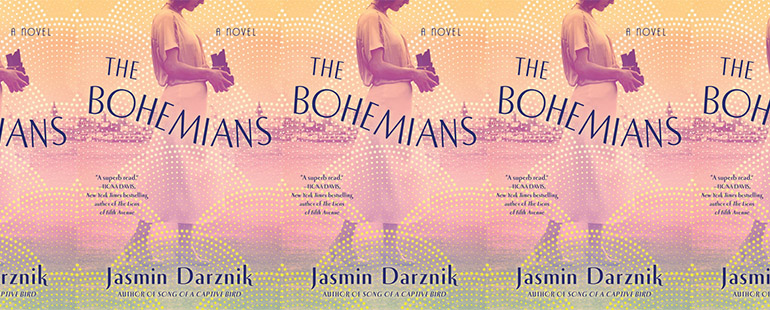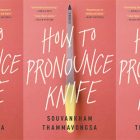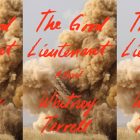“What drew me to Lange was her desire to make lives of the unseen seen”: An Interview with Jasmin Darznik

“When I was younger, I wanted to walk in the world as if I were invisible,” reflects Dorothea Lange, in Jasmin Darznik’s second novel, The Bohemians, published earlier this year. “Slowly I came to realize you couldn’t really see people if you’re bent on hiding all the time. You had to show people who you were if you hoped they’d show you something of themselves. You had to let yourself be seen.” This progression—from invisibility to being seen—describes the scope and arc of Darznik’s newest narrative, which imagines the early adulthood of photographer Dorothea Lange, before she becomes famous.
The novel begins in 1918, when 23-year-old Lange arrives by train in San Francisco where she plans to spend a few weeks before heading to Mexico. Pickpocketed, Lange, who is already poor, finds herself stranded with nothing but her camera, which she pawns in order to survive. This unpleasant introduction to the city reverses itself as she is quickly enmeshed in the bohemian art scene; the novel takes off from here, chronicling Lange’s deep friendship with an aspiring fashion designer named Caroline Lee, the opening of her portrait study on 540 Sutter Street, and her romance with the painter Maynard Dixon, whom she later marries and divorces. Throughout, the city shapes her as she bears witness, noticing not only her wealthy patrons but also impoverished communities, such as those hit hardest by the 1918 Spanish flu and the enslaved women in Chinatown’s brothels.
Reliant on photography for income, Dorrie, as she’s nicknamed in Darznik’s narrative, initially rejects the title of “artist” and the assumptions that go with it. Photography, she claims, is her trade, and she pursues it as a business, getting a loan typically off-limits to women in order to start her own portrait studio, which she caters to elite clientele. She eventually becomes financially independent, no small feat for an unmarried woman in the 1920s. And yet, conversations with other women artists—particularly the photographer Imogen Cunningham and the journalist Consuelo Canaga—provide Dorrie with the confidence to start taking street photos, for which she receives no commission. Empathy drives her best work. Consider, for example, her most famous portrait, Migrant Mother, Nipomo, California, which depicts a working-class mother surrounded by children as she stares off into the distance, eyes squinting with worry. No longer hiding behind her camera, Dorrie’s street portraits reveal not only her subject but also her own artistic and moral ethos. Her best portraits require her own emotional vulnerability. Photography, she comes to accept, is as much about the seer as it is about the seen.
Ultimately, Darznik’s approach towards the historical novel isn’t unlike Dorrie’s attitude towards portraiture. Darznik, like Dorrie, focuses on characters often overlooked: immigrants, women, and people of color; she marries attention to archival detail with her ability to richly imagine untold histories. This interest is evident in her previous books as well. Her memoir, The Good Daughter: A Memoir of My Mother’s Hidden Life (2011), recounts her mother’s first marriage, at thirteen, and the child she left behind when she moved from Iran to California. And Darznik’s first novel, Song of a Captive Bird (2018), imagines the life of Iran’s beloved poet Forugh Farrokhzad, a woman who refused to live a life of quiet modesty and instead left a suffocating marriage to pursue a life of poetry. In their empathetic attention to the lives of overlooked women, Darznik’s and Lange’s values dovetail. “Stories are everywhere,” Darznik writes in The Bohemians, referring as much to Dorrie’s values as her own. “Wherever there are people, there are stories to tell and pictures to make.”
Anya Groner: In many ways, The Bohemians is a love song to San Francisco. The city is described in glorious detail, both its beauty and its ugliness—particularly its vicious cruelty towards Chinese and Chinese American residents. You grew up near San Francisco. What is your own relationship with the city? Did you also experience the wild charm and unapologetic cruelty of the city?
Jasmin Darznik: My family and I came to the Bay Area from Iran in 1979, the year of the Revolution. I imagine for my parents San Francisco was as far as you could go from the Islamic Republic without falling off the face of the earth. They were in awe of all that freedom—and a bit intimidated by it, which of course made it all that much more alluring to me as I was growing up. The city’s wild charm hit me hardest when I was a teenager. I spent hours and hours traipsing around North Beach. It was not easy to be Iranian in America (it’s still not), so I definitely experienced episodes of “unapologetic cruelty.” Still, there is a freedom-loving feeling to San Francisco, a reverence for the eccentric and the outsider that has always made it feel like home.
AG: Early in the book, the investigative journalist Consuelo Kanaga cautions Dorrie “not to confuse what you read for what’s really going on.” Her advice struck me as words any historian or writer of historical fiction might live by. Your novel delves into archival gaps, illuminating tales less often told: Dorothea Lange’s life before she was famous; the experience of a Chinese American woman living in a city and a time that seeks to destroy her; the friendships between women artists. This seems to be what historical fiction is made for—imagining what the archives can’t tell us. Can you tell me about your research process? What challenges and opportunities did you discover in pursuing these lesser-told narratives? When do you give yourself permission to invent narratives and characters and when do you feel beholden to the archives?
JD: To the extent that I have a process, it’s to let my curiosity serve as a compass. Probably my methods would horrify a trained historian, but I’m mainly steeping myself in a period and a place by reading what interests me about it. Often, it’s the micro-histories that yield the most material. For instance, with The Bohemians I spent a long time looking at the design of the city after the 1906 Earthquake, especially in terms of how women occupied public spaces. I knew I wanted characters who moved through the city, whose identities were shaped by their daily interface with its people, buildings, landscapes. What would it be like for a mixed-race woman to walk down Market Street in 1918? How about a white woman journalist in Chinatown? Scenes and character development both sprang from questions like that.
My rule for myself when writing biographical fiction is that I won’t write what’s dissonant with known facts I encounter. That leaves a lot of room for invention, thankfully. In creating the character of Caroline Lee, a Chinese American woman who becomes her assistant in the novel, I worked backwards from Lange’s commitment to racial justice, especially through her photographs of the Japanese Internment. It’s true that Lange had a Chinese American assistant in her first portrait studio, and giving her a prominent role in the story felt consonant with her values and vision.
AG: Toward the end of the novel you write that “A portrait is many things. A document, a moment in time, a refuge for memory. But above all, it is the meeting of two people, the seer and the seen.” As a photographer, Dorothea Lange is the seer, but in creating The Bohemians she is seen by you, the writer, and also by your readers. Do you see parallels between the work of a photographer and the work of a novelist? More specifically, what connections do you find between Dorothea Lange’s artistry and your own?
JD: What drew me to Lange was her desire to make lives of the unseen (Dust Bowl migrants, people of color, “alien” immigrants) seen. Everything I’ve written—the memoir of my mother; the story of Iran’s great woman poet, Forugh Farrokhzad; and now this novel about Lange and her assistant—has been shaped by a similar desire. Lange’s conception of photography was that it always inevitably reflects back a picture of the photographer. When we look at Migrant Mother, for example, we’re also looking at Lange as she was in the moment she took that picture—a working mother, enmeshed in love for her children and her guilt about leaving them. In other words, every portrait is a double portrait, of the subject and the artist. That’s true of writing, too. What seems different is the extent to which a photographer must place herself in proximity to her subject. As a novelist I’m preoccupied with people’s stories, but I can write about them from a distance, from within a place of solitude.
AG: Friendships between women are at the center of both The Bohemians and your debut novel, Song of a Captive Bird. In these books, women rescue each other from dangerous relationships, and they support each other’s artistic development and vision. In many ways, your women characters really understand one another, much more so than their lovers, who are men. I imagine the details of friendships between women are hard to unearth in historical documents. Stories of artists are so often focused on individual genius, but your novels give homage to the role of social scenes and platonic love in supporting and developing artists. Can you tell me more about these central relationships? How did you discover and/or invent these characters? Why did you choose to emphasize these relationships?
JD: The novel, at least in its English and American iterations, has privileged the love plot. So, too, does so much modern entertainment. I’m not uninterested in that aspect of women’s lives, but I don’t think it’s necessarily the most dramatic or worthy topic to write about. When I was reading about Forugh Farrokhzad, it was always her lover who got top billing in her story. The not-so-subtle subtext was that he was the one who shaped her, who made her who she was. I just didn’t buy it. Reading between the lines, I saw that her mother and sister were very important to her, and so was the friend who took her in at the bleakest point in her life. It would have been disingenuous to write a story about her that didn’t include these relationships.
I went through a similar experience when writing about Dorothea Lange. To the extent we know her, it’s as a solitary woman genius. That’s not true, at least not the solitary part. When she came to San Francisco in 1918, she fell in with a number of women photographers. There was Imogen Cunningham, who was far more established. There was Consuelo Kanaga, who was engaged in the kind of documentary photography Lange would take on a decade later. Each friendship sharpened her vision of who she wanted to be. This isn’t fiction; it’s the truth. We just haven’t had the stories to tell women’s stories as they really were.
AG: I reveled in the fashion throughout your novel. Outfits are so lavishly described. I’ve seen some of your own extraordinary vintage clothing in photos on your Facebook page. What’s your favorite outfit in the book? How did your research about fashion, an art traditionally associated with women, help you imagine the time period and get into the minds of characters?
JD: To write anything, I have to see it in my mind’s eye first. Places, people, objects—all these are portals to the imagination. Style and fashion are two of my favorite portals, and in making one of the main characters, Caroline Lee, a dressmaker, I was able to really indulge my fascination with them. As a mixed-race woman living in segregated San Francisco in the 1920s, style is both her livelihood and her weapon. It’s how she makes herself visible in a world that wants her to disappear.
But sometimes what a woman wants or needs most is to disappear. That other aspect of style—its power to make you invisible—comes out in my favorite outfit from the novel. Dorothea Lange walked with a limp, a carryover from her childhood bout of polio. Intensely aware of how her limp made her look to other people, she developed various ways of hiding it, including how she styled herself. In the novel, when she first starts venturing out in San Francisco, she pulls on an old mackintosh and a man’s fedora. She revels in how much freedom the “costume” affords her, how it lets her take in the city in a way that wasn’t possible before. I loved writing that scene. It reminds me of how style can make you see yourself differently—and therefore also move differently in the world.
AG: In the novel you pay much attention to white nationalism and the anti-Asian sentiment and laws prohibiting Chinese residents from walking freely and safely through San Francisco, an aspect of life that would’ve been adjacent to Dorrie’s experience. As a white woman with a limp, she experienced discrimination based on her sex and ability, but her race afforded her significant freedoms. Multiple times throughout the novel, she struggles to understand the cruelty and violence her assistant and best friend, a mixed-race Chinese-American woman, faces. Yet affection perseveres. This felt triumphant to me, two women able to love one another through pain when their personal experiences diverge. What is the relationship between identity and empathy? What enables Caroline to accept Dorrie’s love even as she tells Dorrie that she’ll never understand what it’s like to be her?
JD: Lange’s greatness centers on her capacity for empathy. But empathy can’t carry you all the way into someone’s reality. There’s always a gap, a potential for misunderstanding or a false confidence in our ability to know others. As a photographer, Lange would have been mindful of these tensions, but I imagine the stakes would have been much higher or at least more tangible in a friendship. The Bohemians is as much about the limitations of empathy as about its potential. The friendship between Dorrie and Caroline survives those limitations because each woman is genuinely loving and present to the other.
AG: I’ve always thought of Dorothea Lange as a working-class photographer, an impression garnered from her portraits taken during the Dust Bowl Migration and the Great Depression. I was surprised to learn that she ran a portrait studio catering to wealthy clientele. And yet, her studio is evidence of her working-class background. She needs money and holds no illusions about the necessity of cultivating high-paying clientele. In the novel, Dorrie pushes back against the label of artist, identifying more as a worker, a distinction that reveals much about gender and class. She’s gritty and determined and hard-working. I found myself cheering for her business to succeed. How were you able to home in on this essential conflict in her attitude towards her photography? Dorrie’s pragmatic attitude affords her financial independence, but at a great cost. She’s wedded to the studio, rarely taking breaks. What are the costs and benefits of her extraordinary work ethic? What can today’s artists learn from Dorrie’s entrepreneurism?
JD: It feels like an almost irreconcilable tension, doesn’t it? Between Lange, the society photographer, and Lange, the documentary activist. She did not come from money. As a working woman, and often the sole breadwinner of her family, she had no time to indulge in dreams of becoming an artist. Of course, she brought an artist’s eye to her work, but it was for her very much work. Lange never stopped taking portraits—it was that with the Depression she changed the subject of her portraits to ordinary people, and she worked just as hard for them than she did for her wealthy patrons.
The costs were, as you say, significant. By her own admission, she was not a “good mother.” Her work took her away from her children for long periods of time, and they grew up resentful. My sense is that she felt her work was necessary—to support her sons, for one, but also, and not insignificantly, because she felt herself called to do it. In rejecting her ambition, she would have been rejecting a vital part of herself. Later, as she grew older, her extraordinary work ethic took a toll on her body. She’d had polio as a child and in the last decades of her life she experienced post-polio syndrome and other physical ailments. And yet when you watch footage of her in the last year of her life when she’s putting together photographs for the Met’s major retrospective, you see how very much she loves her work. Whatever it cost her, it was the point of her life.
This piece was originally published on September 27, 2021.



